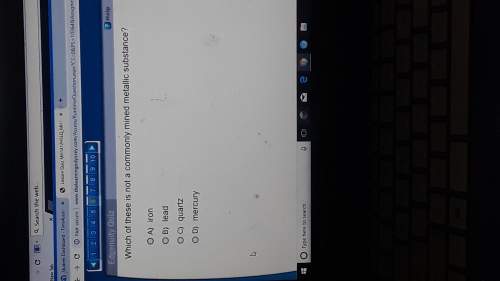1. mendeleev organized elements in his periodic table in order of increasing
2. you ar...

1. mendeleev organized elements in his periodic table in order of increasing
2. you are given the melting points of three unknown substances and are asked to predict which one is an ionic compound. you would select the compound with the melting point.
3. two factors that determine whether a molecule is polar are the types of atoms in the molecule and the of the molecule.
4. according to john dalton’s observations, when elements combine in a compound
a. the ratio of their masses is always the same.
b. each element contributes an equal number of atoms.
c. their volumes are always equal.
d. their masses are always equal.
5. democritus thought that matter was made of tiny particles
a. of earth, air, fire, and water.
b. that could not be divided.
c. that could be divided.
d. that were all round and smooth
6. rutherford’s gold foil experiment provided evidence for which of the following statements?
a. negative and positive charges are spread evenly throughout an atom.
b. alpha particles have a positive charge.
c. gold is not as dense as previously thought.
d. there is a dense, positively charged mass in the center of an atom.
7. which statement about subatomic particles is true?
a. protons, neutrons, and electrons all have about the same mass.
b. unlike protons or neutrons, electrons have no mass.
c. neutrons have no charge and no mass.
d. an electron has far less mass than either a proton or neutron.
8. which statement is true about oxygen-17 and oxygen-18?
a. they do not have the same number of protons.
b. their atoms have an identical mass.
c. they are isotopes of oxygen.
d. they have the same mass number.
9. which statement accurately represents the arrangement of electrons in bohr’s atomic model?
a. electrons vibrate in fixed locations around the nucleus.
b. electrons travel around the nucleus in fixed energy levels with energies that vary from level to level.
c. electrons travel around the nucleus in fixed energy levels with equal amounts of energy.
d. electrons travel randomly in the relatively large space outside the nucleus.
10. what does the electron cloud model describe?
a. the most likely locations of electrons in atoms
b. the precise locations of electrons in atoms
c. the number of electrons in an atom
d. the mass of the electrons in an atom
11. what is the difference between an atom in the ground state and an atom in an excited state?
a. the atom in the ground state has less energy and is less stable than the atom in an excited state.
b. the atom in an excited state has one fewer electron than the atom in the ground state.
c. the atom in an excited state has more energy and is less stable than the atom in the ground state.
d. the atom in an excited state has one more electron than the atom in the ground state.
12. the usefulness of mendeleev’s periodic table was confirmed by
a. the discovery of subatomic particles.
b. its immediate acceptance by other scientists.
c. the discovery of elements with predicted properties.
d. the discovery of the nucleus.
13. atoms of the most reactive elements tend to have
a. one or seven valence electrons.
b. eight valence electrons.
c. four or five valence electrons.
d. no valence electrons.

Answers: 3
Other questions on the subject: Chemistry

Chemistry, 21.06.2019 19:30, mazielynn84
How many molecules of sucrose c12h22o11 are there in 454 grams of sucrose
Answers: 1



Chemistry, 22.06.2019 19:50, jakaylathomas11
A2.5% (by mass) solution concentration signifies that there is a 2.5 % (by mass) solution concentration signifies that there is blank of solute in every 100 g of solution. of solute in every 100 g of solution
Answers: 3
Do you know the correct answer?
Questions in other subjects:


Mathematics, 11.02.2021 09:40

Mathematics, 11.02.2021 09:40


History, 11.02.2021 09:40

Mathematics, 11.02.2021 09:40

Biology, 11.02.2021 09:40

Mathematics, 11.02.2021 09:40


Mathematics, 11.02.2021 09:40







